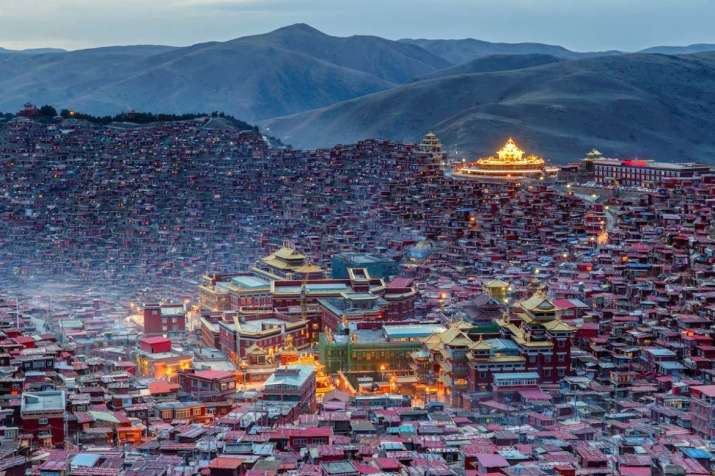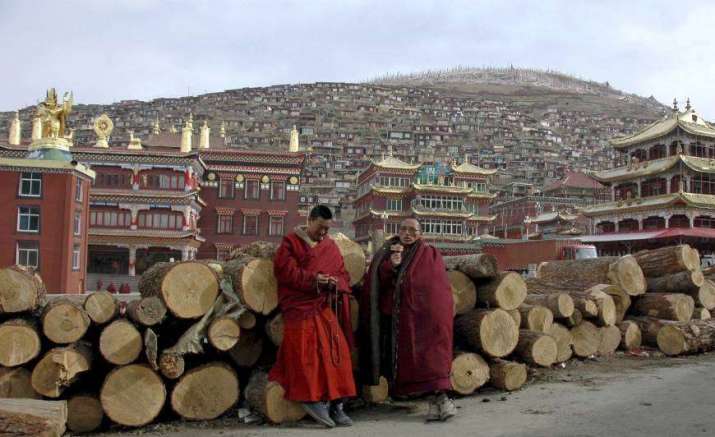NEWS
China Appoints Communist Party Officials to Manage Larung Gar Buddhist Academy
 Larung Gar Buddhist Academy. From balancedachievement.com
Larung Gar Buddhist Academy. From balancedachievement.comAmid widespread media accounts of a government-ordered reduction of the monastic population at Larung Gar Buddhist Academy in the western Chinese province of Sichuan, the state authorities have reportedly appointed Communist Party and government officials to take up key management and supervisory positions at the monastic academy, in a move apprently aimed at tightening state control over the running of the educational institution.
Situated in a remote valley in the traditional Tibetan region of Kham, Larung Gar Buddhist Academy was founded in 1980 by the highly respected teacher Khenpo Jigme Phuntsok (1933–2004), a lama of the Nyingma tradition of Tibetan Buddhism. The reported appointment of six party members to key administrative roles at the monastery in Serthar County, Garze Tibetan Autonomous Prefecture, comes in the wake of a year-long program involving the demolition of residences in the valley and mass student evictions.
Since its inception, Larung Gar has been an independent center of education administered since Jigme Phuntsok’s death by a groups of senior monks. The six new appointees will include Garze Prefecture’s former deputy police chief, who will become Larung Gar's party secretary and its director—a role currently held by lama Ani Mumtso, the niece of Jigme Phuntsok. All six are reported to be ethnic Tibetans.
“The appointments will help the school operate in accordance with laws and will not affect its teaching, since the officials will be administrators,” Penpa Lhamo, deputy head of the contemporary studies institute of the Tibet Academy of Social Sciences was quoted as saying. (Associated Press)
In June last year, the Sertar County government issued an order stating that by October 2017 only 1,500 monks and 3,500 nuns would be permitted to live at the monastic college. The order follows similar moves in 2001, when the authorities organized a mass eviction of residents from the institute, and in late 2015, when further expulsions were accompanied by an order to reduce admissions to curb the rapid growth of the monastic population. The order did not give a reason for the decision, but cited two central government meetings during which Chinese President Xi Jinping had stressed “national unity” and the necessity for religious groups to support the Communist Party and “merge their religious doctrines with Chinese culture.” (Los Angeles Times)
Before the latest move to limit the monastic population, an estimated 10,000 monks, nuns, and lay students lived in small wooden cabins spread over the hillsides surrounding the sprawling monastery complex, although some estimates put the number as high as 40,000. Larung Gar is widely considered to be the largest center of Buddhist learning in the world.
Overseas Tibetan groups have suggested that the state authorities aim to contain the spread of Tibetan Buddhism, which has recently grown in popularity among Chinese people outside of traditionally Tibetan regions. Earlier this year, a government spokesman for Sichuan’s Sertar County asserted that demolition work at Larung Gar was aimed at improving safety and public health at the monastic complex. “The purpose of the renovation is to improve the living standard of the residents there and eliminate fire hazards,” county government spokesman Jiang Zhiming was quoted as saying. The official added that only some buildings had been demolished to allow access for emergency services. (The Globe and Mail)
 Buddhist monks stand in front of Larung Gar, in southwestern Sichuan Province. From japantimes.co.jp
Buddhist monks stand in front of Larung Gar, in southwestern Sichuan Province. From japantimes.co.jpThe site of Larung Gar was chosen by Khenpo Jigme Phuntsok because of its historical connection to the Vajrayana tradition. It is said that His Holiness the first Dudjom Rinpoche, Dudjom Lingpa (1835–1904) stayed here with 13 disciples. The academy was conceived as an independent center of study that would help revitalize the Dharma and revive the study and practice of Tibetan Buddhism following China’s Cultural Revolution (1966–76), during which Tibetan Buddhism was suppressed and thousands of monasteries were destroyed. The institute has become renowned for the quality of both its religious and secular education. English, Chinese, and Tibetan languages and modern computer studies are taught alongside a traditional non-sectarian Buddhist curriculum. About 500 khenpos—holders of doctoral degrees in divinity—have studied at Larung Gar Buddhist Academy.
See more
CHINESE COMMUNIST OFFICIALS TO RUN TIBETAN BUDDHISM CENTER (Associated Press)
In Tibetan Buddhist heartland, Communist Party takeover threatens religious academy’s soul (South China Morning Post)
Larung Gar set to be run by Communist Party members (Phayul.com)
Why Is China's Government 'Demolishing' a Tibetan Buddhist Monastery? (The Diplomat)
China says rebuilding major western Buddhist learning centre (The Globe and Mail)
For 2nd time in 15 years, Tibetan Buddhist academy in China faces demolition order (Los Angeles Times)
Related news from Buddhistdoor Global
Reports of Residential Demolitions at Yarchen Gar Monastic Community in China
Senior Abbot at Larung Gar Says Evictions Almost Complete; Demolition Target Reduced
China Official Says Rebuilding Underway at Larung Gar, 800 Resettled
State Authorities Cancel Annual Buddhist Ceremony at Larung Gar Institute
Government Workers Begin Demolishing Buildings at Larung Gar Buddhist Academy
Related features from Buddhistdoor Global
The Wonders of Kham and Larung Gar
The Wonders of Kham and Larung Gar, Part Two














